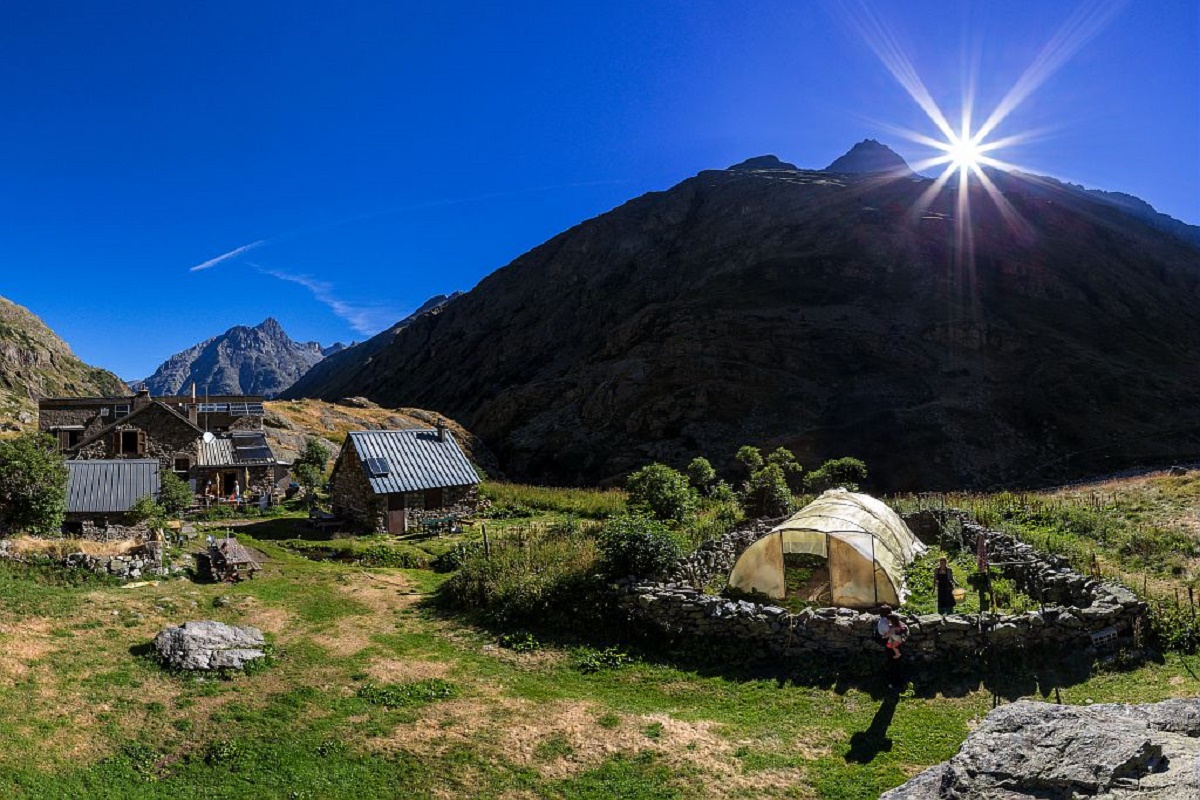
2. From the Alpe du Pin refuge to La Lavey refuge
After limbering up along the pleasant mountainside paths of Alpe du Pin, cross the fine forest of Les Bans and you arrive at the River Vénéon. Spruce, birch and moss of all kinds blend with the ruins of La Gassaudière to create an atmosphere filled with mystery. The mystery disperses slowly as you reach the Alpine pastures of La Lavey and its splendid view of the tall summits of the Aiguille de l'Olan and the north face of Les Rouies.
At the Lavey refuge, a mountain atmosphere and world cooking have pride of place.
Description
- At the signpost, turn left towards Le Clot.
Return trip possible to the very beautiful glacier valley of La Mariande. Go up as far as the first sloping ledge with its large stone blocks - a great place for a picnic. Duration 1 hr 30 mins. Return the same way as far as the signpost. - Cross the Mariande stream and climb up to the Gassaudière ruins. Descend through a beautiful forest until you overlook the Vénéon.
- Turn right towards Lavey. The path winds through short, steep sections to the hamlet of Souchey.
- At the last few houses, take a flat path towards Lavey. The path leaves the woods and reaches a small scree slope, then descends towards the Muande stream. Follow the gentle slope up the left bank to the Lavey refuge.
- Departure : Alpe du Pin refuge
- Arrival : La Lavey refuge
- Towns crossed : Saint-Christophe-en-Oisans
13 points of interest
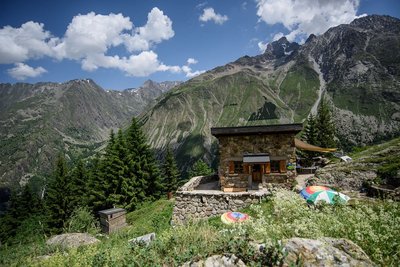
Refuge de l'Alpe du Pin - Parc national des Ecrins - Mireille Coulon  Hut
HutAlpe du Pin Refuge
The Alpe du Pin Refuge is little known and discreet, and stands on the mountain pasture of the same name. It belongs to the Jarrets d'Acier association. It has everything needed to delight the heart, the soul and the calf muscles! Built in 1947, it has preserved its humble origins down the years by making reasonable adaptations to the needs of contemporary comfort. The Alpe du Pin Refuge is located at an altitude of 1,805 m, at the foot of the Tête de Lauranoure (3,325 m), the view of which from St-Christophe leaves no one indifferent. With a capacity of 20 places in a single dormitory, the visitor soon feels at home, and the layout of the refuge helps promote meetings and conversation. You can count on a simple, warm and friendly welcome from the refuge keepers.
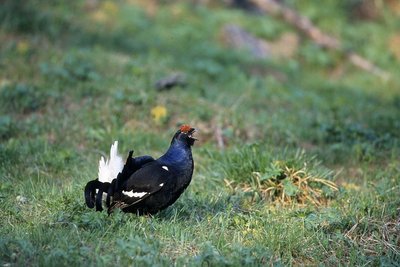
Tétras lyre - Robert Chevalier - PNE  Fauna
FaunaThe habitat of the black grouse
The black grouse is a galliforme (fowl-like) bird and lives at altitudes of between 1,400 and 2,300 metres. It thrives in the semi-open patchwork habitats. These criss-cross habitats of heather moors, grassland and bushes or open woodlands enable it not only to find food for its young (insects, small flowers) in the breeding season (July) but also offers sufficiently tall vegetation cover in which to hide and escape the attention of predators. Song counts are carried out in spring to estimate the number of singing males. Summer counts, using pointer dogs, are also carried out to assess the number of broods in the year.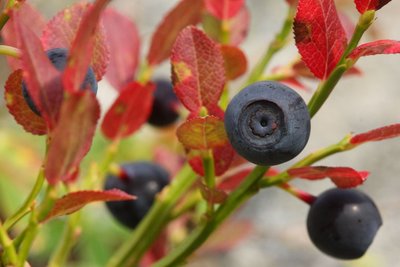
Myrtille commune - Marc Corail  Flora
FloraThe European blueberry
The European blueberry belongs to the Ericaceae family. It is sub-shrub with dense foliage growing 20 to 60 centimetres tall. Its small leaves are supple, alternating, oval and finely toothed. From August, the edible berries with purplish red pulp, hence its popular name gueule noire (meaning black mouth). They turn the slopes of the sub-alpine meadows a beautiful red colour in late summer. It sometimes grows with the bog bilberry (Vaccinium myrtillus) which has white flesh and smooth leaf edges.
The picking of this berry is subject to special regulation. Within the Parc National des Écrins, it is limited to 1 kg per person per day, and the use of comb-type berry pickers is prohibited. In the area covered by the Parc National des Écrins and throughout the Department of Isère: 1 kg per person per day and the use of comb-type berry pickers is prohibited before 15 August.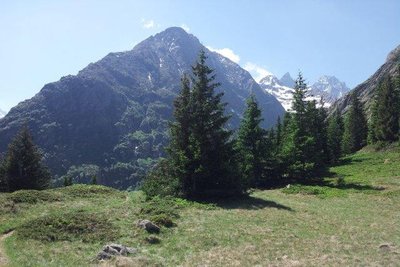
Zone humide - PNE  Flora
FloraWetlands
Wetlands are special habitats characterised by the presence of water - fresh or salt, permanent or temporary. Diverse yet threatened, these environments contribute to shaping the landscapes and constitute an important habitat for numerous animal and plant species. Their conservation is vital if wide biodiversity is to be maintained. High-altitude marshlands or bogs exemplify this.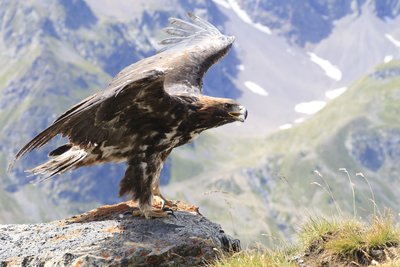
Aigle Royal - Cyril Coursier  Fauna
FaunaThe golden eagle
Once you arrive below the glacial rock bar of La Mariande, you might spot the golden eagle. This majestic bird of prey has dark plumage, the juveniles with beautiful white markings under the wings, soar close to the sunny slopes in order to gain height, looking for prey. It flies alone or with its mate, unlike its cousin, the griffon vulture, which is usually seen in groups. The pair of eagles occupies a large home range, in which several eyries are built. The female usually lays two eggs in the spring. These hatch into eaglets although generally only one will survive. So if you are out walking in late July, keep an eye out - you may be lucky enough to spot a fledged juvenile!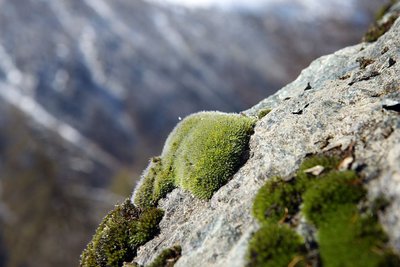
Grimmia alpestris sur un rocher - © Parc national des Ecrins - Cédric Dentant  Flora
FloraMosses
Bryophytes, more commonly known as mosses, are perfectly adapted to humid woodland environments, and are a vital component in the forest eco-system. A very ancient plant family, they reproduce through an archaic system of spores, and water is needed for their gametes to meet. They do not have roots, strictly speaking, but a system of rhizomes enabling them to be fixed to the soil, to a tree or a rock. They have the particularity of being able to survive when completely dehydrated in times of drought. This is called the reviviscence.

Epicéa - © Parc national des Ecrins - Bernard Nicollet  Flora
FloraNorway spruce
The cones of the fir tree, firmly fixed on the branches and standing like large candles, are hard to spot since they grow right at the summit of the tree. But the cones of the spruce hang from the end of the branches and fall to the ground when ripe. As for the leaves, the spruce's needles are slightly prickly, but not the fir tree's, which retain a characteristic deep green colour to the point of featuring on colour palettes as "pine green".
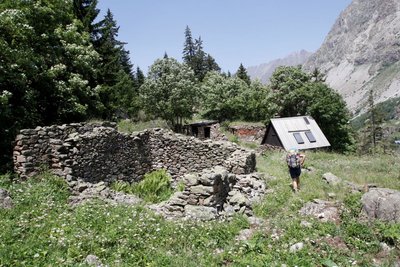
Le hameau du Souchey - Cyril Coursier - Parc national des Ecrins  History
HistoryThe chalets of Le Souchey
The birth of Alexandre EYMARD in Le Souchet in July 1881 shows that these summer pasture chalets were lived in at that time. Back then, every year, from mid-June to mid-September, the village of Le Souchet was the home of four families. Every summer, the women went with their children up to Le Souchet, while the men stayed in the villages in the valley.
The animals (sheep, goats and cattle) joined in the summer journey. The prairies around the village were mown, the hay gathered in and taken down to the valley in autumn, with the help of a cable running to Champhorent.
The families' livestock included, in general, about two cows, a dozen goats and fifty or so sheep.
In summer, the cows and goats were milked in the morning and evening to make cheese.
In the valley, the men collected the fodder, and some worked as mountain guides, an important extra source of income in the Alps.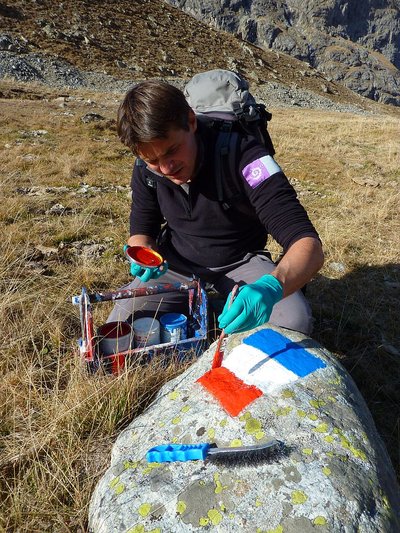
Garde moniteur peignant les limites de la zone coeur du Parc - Cyril Coursier  History
HistoryA flag on the rock: the central area of the National Park.
At the entrance of the Mariande valley, and in the Lavey valley, you can see red, white and blue flags, marking the limits of the central area of the Ecrins National Park, where the regulations apply to protect the natural heritage. The limitation area is regularly maintained by the rangers of the National Park.
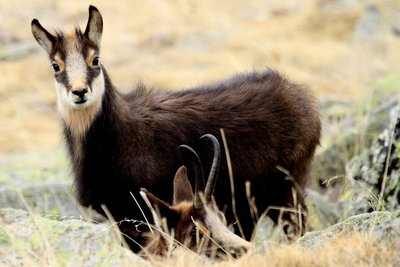
Un chamois - Jean-Philippe Telmon  Fauna
FaunaChamois
An animal symbolising the Alps, the chamois or "goat of the rocks", as it is nicknamed, has short black, hooked horns. Like the Alpine ibex, it is easier to observe with binoculars. The females and young males like to group together in large herds; the older male goats, however, are more solitary and only join the females during the mating season. In winter, the chamois are keen to preserve their tranquillity, since they can only survive by preserving their reserves of fat.
In the Lavey valley, the chamois are most easily seen in spring, when they come down from the high altitudes, attracted by the grass growing, and in autumn, during the breeding season, when it is quite common to see a male chasing another away from one slope to the next.
Maison en pierre et toit en ardoise au hameau de la Raja - Cyril Coursier - Parc national des Ecrins  History
HistoryThe deserted habitat of the Muande valley
The Lavey valley has a dozen deserted high-altitude habitats, including the Raja and Le Souchet. An analysis of charcoals has brought to light a probable habitation of the valley in the 13th century.
The present-day buildings in the valley date from the 18th and 19th centuries.
A number of elements are shared by all the deserted dwellings around St-Christophe en Oisans : high altitude (1,900 to 2,000 m on average), an original architecture made exclusively of dry stone with materials found onsite, and that is very robust, and has a small indoor area (from 8 to 40 m2)
They reveal the existence not only of buildings (houses and outbuildings), but also of an intricate series of walls, terraces and enclosures, dividing the land and corresponding perhaps to older agricultural divisions or to the material form of a complex distribution of land.
They show, above all, the tenacious, exceptional and hard-working presence of human beings who, at the cost of considerable labour, colonised and worked on the smallest parcel of land all the way up to the foot of the rocks and the glaciers.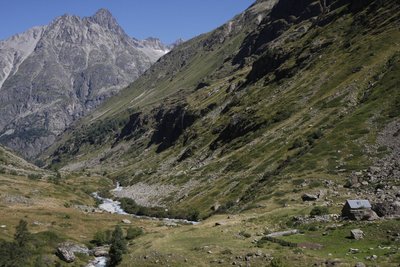
Pastoralisme dans le vallon de la Muande - © Parc national des Ecrins - Mathias Magen  Pastoralism
PastoralismPastoralism in the valley
Today, each year, in mid-June, some 800 sheep go up towards the Lavey valley. They are divided into flocks of about 400 animals each, and belong to two Oisans breeders. During the summer, they each occupy one of the slopes, and then return to the valley around 10 October each year. To make sure the two flocks do not mix, the Pierre bridge across the Vénéon has a wooden barrier that must be carefully closed each time visitors go through it. The flock currently grazing on the left bank of the valley has been going up each summer to this Alpine pasture for 35 years was previously led up by a local breeder.
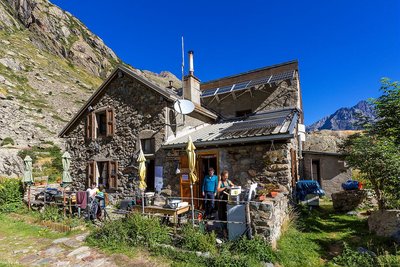
Le refuge de la Lavey - Bertrand Bodin  Hut
HutThe Lavey refuge
This is a refuge in the Ecrins range, at an altitude of 1,797 m in the Lavey valley, which leads to the Vénéon valley.
In 1881, the Isère section of the CAF (Club Alpin Français) bought two buildings in the village of La Lavey. The refuge was renovated and had a storey added to it in 1949 (24 places), and was extended in 1972. It can currently sleep 44 people. The refuge provides access to the lakes of Bèches, Rouies and Muande, with the latter still developing, after the withdrawal of the glacier at the end of the Muande. It is also the starting point towards Tête des Fétoules, Les Rouies, L'Olan, Pointe Maximin, L'Aiguille d'Olan or L'Aiguille des Arias, and a way to pass through the Olan gap towards Le Valjouffrey. One can also pass through the Col de la Lavey to reach the Chardon valley. In winter 2011, a spectacular rock slide, which can still be seen today, with several thousand m3 of rock, occurred near the refuge. The refuge is the culmination of a very fine trail, and famous for its cuisine.
There is also a fine site of climbing stones around the refuge !
Altimetric profile
Sensitive areas
Golden eagle
- Impacted practices:
- Aerial, , Vertical
- Sensitivity periods:
- JanFebMarAprMayJunJulAug
- Contact:
- Parc National des Écrins
Julien Charron
julien.charron@ecrins-parcnational.fr
Recommandations
The diversions via the Mariande valley is very pretty, but the path is rocky. Don't forget that is still a long stage, and don't set off unless you know what you're doing.
Information desks
, 38520 Saint-Christophe-en-Oisans - La Bérarde
Oisans Park house
Rue Gambetta, 38520 Le Bourg d'Oisans
Video presentation of the natural resources of the Oisans mountain and its crafts. Information, documentation about the Park, projections, reading space for children. Accessible to people with reduced mobility. Free admission. All animations of the Park are free unless otherwise stated.
Source

Report a problem or an error
If you have found an error on this page or if you have noticed any problems during your hike, please report them to us here:


